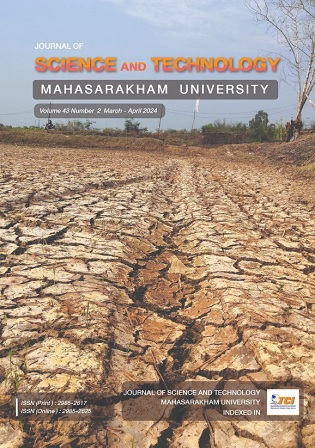Applying spatial statistical analysis to narcotics litigation in Muang Nakorn Pathom, Nakorn Pathom Province
Main Article Content
Abstract
This investigation aimed to discover spatial analysis of drug cases in the responsibility area of Muang Nakhon Pathom Police Station. The data on drug cases between 2013 and 2017 were collected. The purposes of this study were: 1) to examine the pattern of drug cases using Moral's I, 2) to investigate the spatial distribution of drug cases using hot spot analysis based Getis-Ord Gi*, 3) to find out the directional distribution of drug cases using standard deviational ellipse., and 4) to explore the spatial relationship between drug cases and physical factor. The results of the study were as follows: 1) The pattern of the cases over 5 years was clustered according to Moran’s I value, which was discovered at 0.31, 0.34, 0.27, 0.24, and 0.17, respectively; 2) the spatial distribution of cases revealed hotspot areas with a GiZscore greater than 1.65 were discovered at Phrapathom Chedi and Huai Chorakhe districts in 2013 and 2014, Phrapathom Chedi, Wang Takoo, and Sanam Chan districts in 2015, Phrapathom Chedi Huai Chorakhe and Bo Plab district in 2016 and Sanam Chan district in 2017; 3) the directional distribution of the cases over 5 years were distributed to the west of the study area; and 4) urban and built-up land was discovered where most drug cases occurred.
Article Details
References
Abdulhafedh, A. (2017). A Novel Hybrid Method for Measuring the Spatial Autocorrelation of Vehicular Crashes: Combining Moran’s Index and Getis-Ord Gi* Statistic. Journal of Civil Engineering. 7(2), 208-221.
Burachat, J. (2017). Analysis of Current Drug Situation Problem. Journal of Research and Development Institute, Rajabhat Maha Sarakham University. 4(2), 37-56.
Dechsiri, B., & Robert, O. (2019). Drug Trafficking Estimation based on Geo-statistics. Defence Technology Academic Journal. 3(1), 52-61.
In-ain, T. (2018). Developing a Spatial Database for the Application of GIS in Drug Offences Analysis. https://www.agi.nu.ac.th/nred/
Document/is-PDF/2561/geo_2561_018_FullPaper.pdf.
Mungkung, W., & Wacharasin, C., & Deoisres, W. (2016). Family Factors Influencing Substance Abuse in Male Adolescents at a Juvenile Vocational Training Centre. The Public Health Journal of Burapha University. 11(2)., 53-63.
Offce of Drugs and Crime. (2022). World drug report2022. https://www.unodc.org/
Offce of the Narcotics Control Board. (2016). Thailand narcotics control annual report. https://www.oncb.go.th/EN_ONCB/Pages/publications.aspx
Offce of the Narcotics Control Board. (2020). Thailand narcotics control annual report. https://www.oncb.go.th/EN_ONCB/Pages/publications.aspx
Srithamrong, T. (2016). Crime Risk Area Assessment based Geo-Spatial Statics [Master’s thesis, Silpakorn University]
Toju, B., & Okeke, H., & Christain, C. (2014). Crime Mapping in Nigeria Using GIS. Journal of Geographic Information System. 6(5). 453-466.
Tongngern, S., & Supalaknari, S., & Choosakoon kriang, S. (2019). Analysis of demographic data of the offenders and case data of narcotics cases in Ban Pong district in 2015. Journal of Social Sciences. 9(1), 123.-133.
Wongsa, S., & Bualah, K. (2017). Analysis of spatial drug epidemic situation and evaluation of the implementation of drug suppression and prevention strategy in 2016 by the office of the narcotics control board region 6. The National Conference 2017 Conti
nuation Report of the 2nd Conference: Social Development and Administration Strategy. https://www.academia.edu/
Yiampisan, M., & Srivanit, M. (2010). Using the Kernel Density Estimation Surface for Criminal Pattern: A Case Study in Phranakhon District, Bangkok. Journal of Architectural/Planning Research and Studies. 7(1), 87-102.


